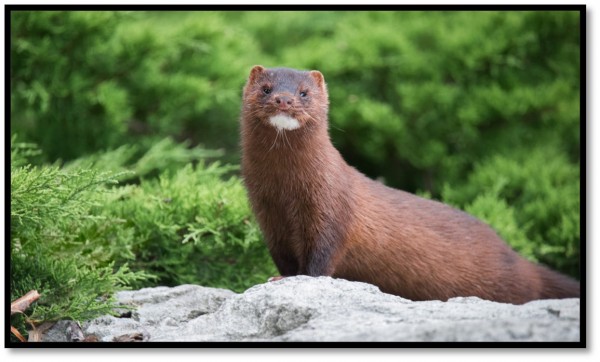Mink

Mink
Neovision vision
-
The mink is a semi-aquatic member of the Mustelidae family. Its relatives include weasels, martens, fishers, fishers, wolverines, badgers, and otters
-
Mink have short, dense, chocolate-colored fur and may have white patches on their chest and belly. The mink's coat is coated in oil to repel water.
-
Mink generally weigh 1.5-2 lbs. with males being larger than females. Adult male mink average two feet in length, including an 8-inch tail.
-
Minks have webbed feet that help them swim.
-
Minks can swim up to 100 feet underwater
-
The mink's fur is very valuable around the world. Because of this, there are farms that raise minks to harvest their fur.
Population: The American mink is common throughout Wisconsin.
Habits: Mink are very active and inquisitive animals, with a keen sense of smell and sight. They are most active at night and in the early morning. On land, they move with a quick, bounding lope, which they can continue for miles. This characteristic lope leaves paired tracks, which stand out in the winter snow along stream banks and beaver ponds. Mink are at home in the water as well, and they swim and dive with ease. They occupy a wide variety of wetland habitats.
To find enough prey, males require a home range up to three square miles, while females use a much smaller range. One mink will have several dens along its hunting route. They den in abandoned woodchuck tunnels, hollow logs, vacant muskrat lodges, holes in stone piles, and beneath large tree roots. Dens are usually near water and may have more than one entrance. Mink line their nests with dried grass, leaves, and feathers.
Diet: Like most mustelids, Mink are agile and fierce fighters, killing prey with a hard bite to the back of the skull. Prey includes muskrats, mice, rabbits, shrews, fish, frogs, crayfish, insects, snakes, waterfowl, and land birds. Mink are opportunists, feeding on whatever is most abundant or most easily caught. They occasionally kill more than they can eat and will cache carcasses in the winter and revisit them to feed. In turn, mink are prey for foxes, bobcats, and great horned owls. In the wild, mink typically live to be two or three years old.
Mating: American minks will carry their offspring for a gestation period of 40 to 75 days. They will give birth to a litter of one to eight babies. These litters are called kits.
Information from: https://dnr.wi.gov/topic/WildlifeHabitat/furbearers.html and https://www.livescience.com/56071-mink-facts.html
To download this info: Click Here
